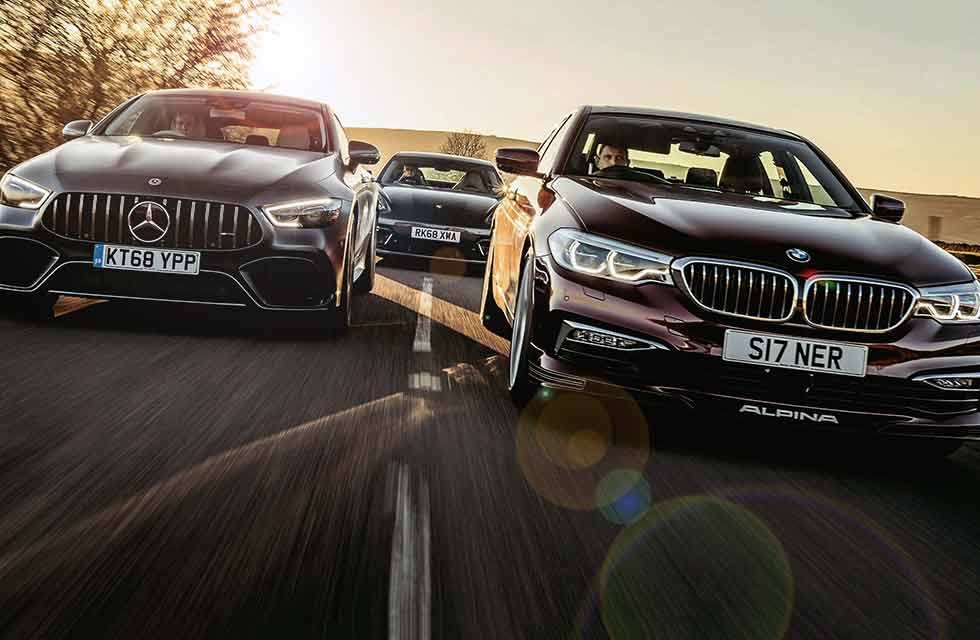
AMG’s GT 4 Door aims to blend sports car punch with saloon comfort – and do it better than the Panamera and Alpina B5. That won’t be easy. Words James Taylor. Photography Alex Tapley.
Giant test The Definitive Verdict New 630BHP GT 4-Door meets Panamera and B5
The fourth dimension AMG X290 vs. Porsche 971 vs. Alpina G30. Giant test: AMG GT 4 Door vs Alpina B5 vs Porsche Panamera For when you absolutely must get there on time, despite leaving very late, and without anything like any effort required from you.

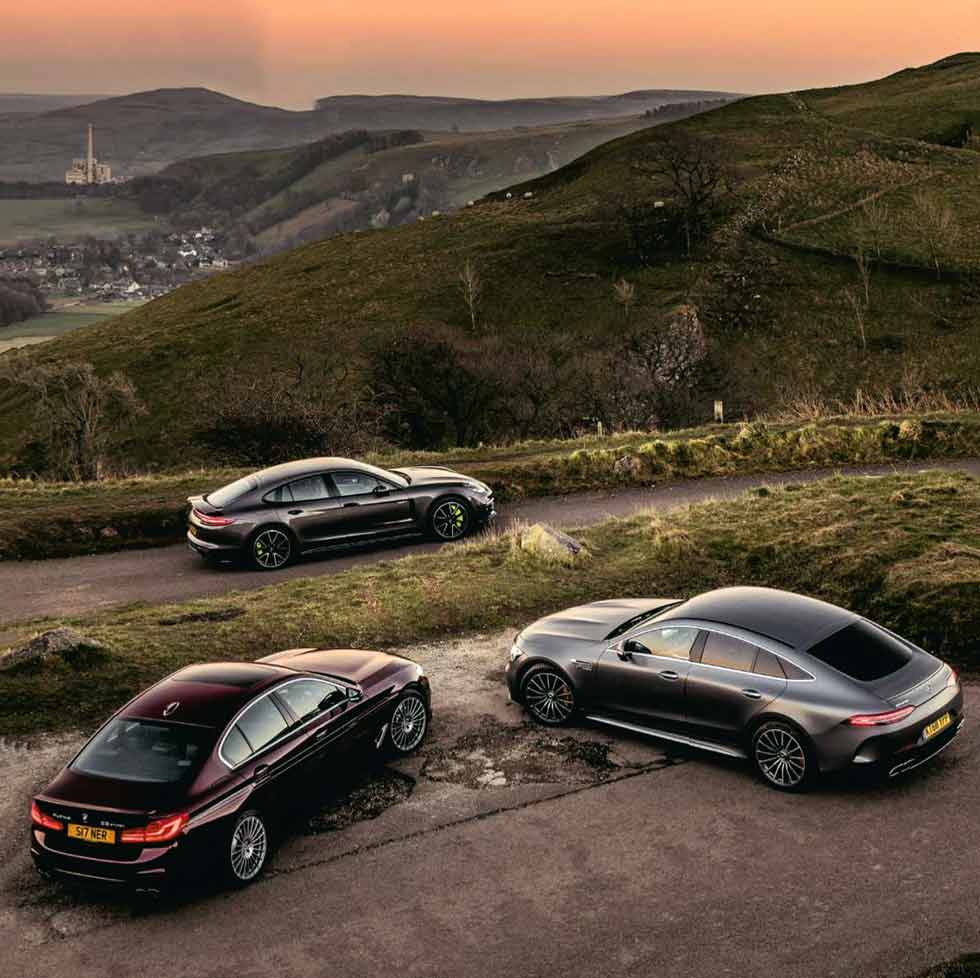
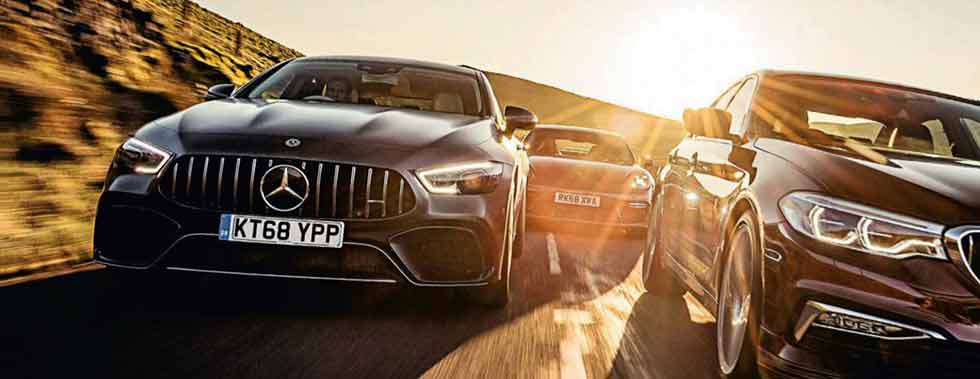
2019 Mercedes-AMG GT 63S 4 Door X290 Pigeon-holers, give up now
In 1978 The Who posed the question, ‘Who are you?’, and it blasts from the GT 4 Door’s Burmester speakers as the AMG and I begin the climb into the Peak District. It’s an appropriate question for the Mercedes-AMG GT 4 Door, a car that’s caused no little puzzlement since it was announced. In name it’s an extension of the two-door, two-seat AMG GT. In the metal it’s rather different. While the two-seat GT uses aluminium chassis architecture derived from 2010’s SLS, the GT 4 Door is altogether bigger, built using the newer, more versatile but heavier platform shared by most of Merc’s rear-driven passenger cars, including the E-Class and the CLS.
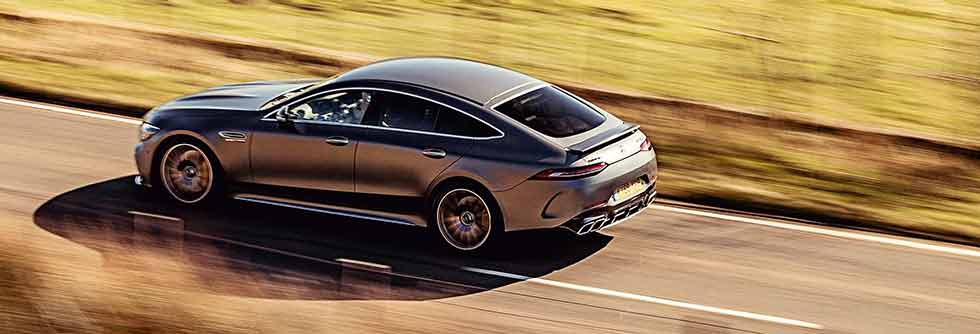
It’s the CLS that this car has most in common with. The CLS range for the UK now tops out with the straight-six mild-hybrid AMG CLS 53, leaving a gap where the previous generation had the mighty V8-powered CLS 63. Mercedes hates a microscopic gap in its range like nature abhors a vacuum – so up steps the GT 4 Door. It beats the CLS for visual drama, and has the muscle to live up to the looks: 577bhp from AMG’s rip-snorting 4.0-litre twin-turbo V8 in the GT 63, or 630bhp in the 63 S variant tested here. That makes it the most powerful Mercedes currently on sale.
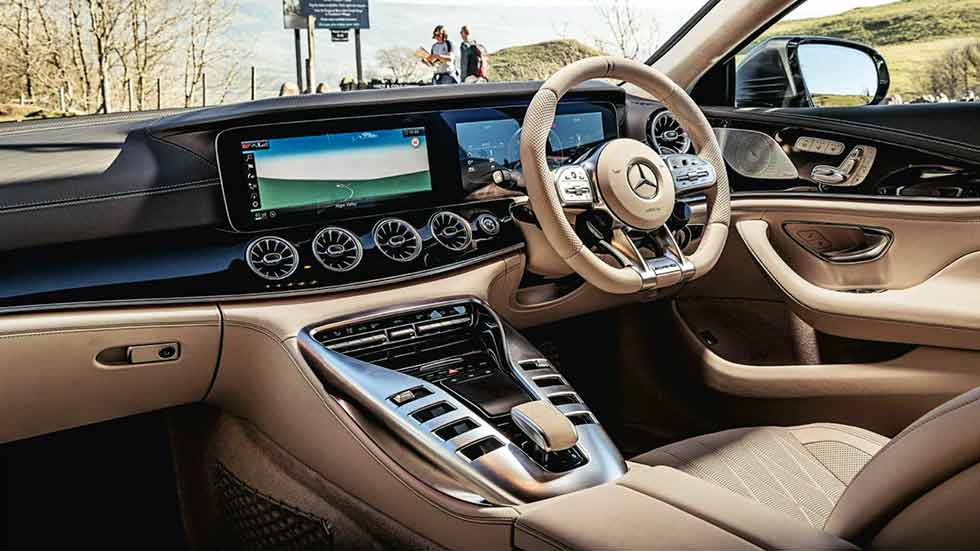
It’s a real statement interior, one right on the cusp of glamour and gaudiness
So it’s not a stretched AMG GT sports car, and nor is it a modified CLS, although it looks a bit like one from a distance, and has similar underpinnings. A hair-splitter might also suggest it has five doors rather than four if you count its top-hinged tailgate hatch. Whatever it is, it’s heading for the same high-end, high-speed, passenger-friendly territory the Porsche Panamera currently occupies (as will the upcoming Audi RS7 and BMW M8 Gran Coupe). And, I’m discovering, it’s tremendously good fun. As it devours the Derbyshire lanes through its shark-like grille with a lip-smacking belch on every upshift, the Merc’s driving position certainly feels more like to a saloon car than a low-slung GT car. A relatively high-set vantage point, it makes up in vision what it lacks in sportiness.
You sit behind Mercedes’ now familiar layout of two giant glossy digital screens, above a swoopy dash peppered with turbine-style climate-control vents, with integrated LEDs that chameleon their way from blue to red as the temperature climbs. Further ambient lighting illuminates the cabin like a coral reef by night, with 64 colours to choose from. It’s a real statement interior, one right on the cusp of glamour and gaudiness. The screens are controlled by touch-sensitive pads on the centre console and the steering-wheel spokes. The interface becomes more intuitive with time but the first few hours can be infuriating until you’re fluent.
Conversely, the GT 4 Door’s handling makes you feel instantly at ease. By rights a car more than five metres long and with more power than a McLaren F1 ought to be a right royal handful, but the GT feels smaller than it is. That’s partly thanks to all-wheel steering helping it into tight corners (and parking spaces), all-wheel drive on the way out of them and the machinations of the active suspension to take care of everything in the middle. The rear wheels are permanently driven, and an electro-mechanical clutch brings the fronts into play when required. Exactly when that is, and with exactly how much torque, is constantly adjusted on the fly. The system feels seamless in action. Feeling all four 20-inch Michelins hooking up to tear at the tarmac out of tight corners is quite a sensation. If you prefer sideways to forwards momentum the S features the same Drift mode as the AMG E63, which turns the car purely rear-driven and disables traction control.
Four-wheel steering means you rarely need to move your hands on the comfortable, chunky steering wheel. Hugely responsive, it requires barely any lock for all but the tightest of turns. It doesn’t feel entirely natural at first, but you quickly dial into it, helped by satisfyingly weighty resistance off centre. One of its spokes wears a plastic clickwheel control like a rosette. That’s the Dynamic Select wheel, which scrolls through the GT’s various driving modes (very much like the Panamera’s mode control). With every click the digital graphic on the wheel shape-shifts; a C for Comfort, for example, through to a chequered flag in ultimate Race mode, and there are yet further options in the media screen to tailor the amount and type of electronic intervention from Basic to Advanced and the flattering-sounding Pro and Master modes.
Each combination of settings changes the interaction between the suspension, all-wheel-drive system, electronic rear differential (standard on the S) and rear-wheel steering. Take the time to work through them and the breadth of the GT 4 Door’s dynamic talents becomes clear; in the upper echelons of its driving modes, its body control and steering response are quite something. A two-tonne car that steers with this level of precision, and with so little bodyroll, is hugely impressive.
The Panamera’s steering, by contrast, is less speedy in response but similarly accurate and with more natural-feeling feedback. Subjectively, the Alpina’s variable-ratio electromechanical steering is the least feelsome of the three, perhaps tuned with high-speed stability in mind, but it’s still a quick rack that requires few turns on these twisting roads. The AMG’s three-chamber adaptive air suspension rides large bumps smoothly (more so than the heavier Porsche) but the smallest lumps ripple through the car, rattling the trim and fittings. I turn up Townshend to compensate, by nudging the volume control on the gigantic console on top of the transmission tunnel. Like the Dynamic Select wheel, its switches are animated with cartoon symbols that alter when pressed; it’s not subtle.
Four fixed seats are standard; a fold-down Business console is an option, as is a folding three-person rear bench. Despite the coupe-style roofline, there’s headroom for a six-foot passenger behind a six-foot driver. The GT 4 Door is about six inches taller than the two-door GT, which makes it look awkward from some angles. It has all the coupe cues (if your definition of coupe stretches to this many doors) but looks like a saloon car wearing GT drag. In some ways it’s an elegant design, with smooth, unadorned surfaces, in others it’s gauche, with false vents in its flanks and those big grilles up front.
AMG’s 4.0-litre V8, which sites its twin turbos in the valley of its vees, is now familiar from a host of Mercs (and Aston Martins) but this is its most potent form yet. With no less than 663lb ft on tap from 2500rpm, the V8’s midrange urge is intense, and the 4 Door feels every bit as fast as its on-paper figures suggest. Not even its hefty kerbweight can blunt the sheer relentlessness of its acceleration. The nine-speed transmission does an admirable job of coping, and while it can occasionally feel slow to dispatch successive downshifts, it can be forgiven considering the amount of twist involved.
Who are you, GT 4 Door GT? Behind the wheel, I quickly cease to care about its confounding image; I’m too busy enjoying myself.
In the upper echelons of its drive modes the AMG’s body control and steering response are quite something. Printed switches are out, animated graphics in. Interior is a visual and tactile treat, although mastering the menus can take a while.
PRE-FLIGHT BRIEFING AMG GT 63S 4 DOOR X290
Why is it here?
The new car in this test, and the most confusing in terms of positioning. Part muscle car, part luxury saloon, part sleek GT, it’s certainly charismatic – even if its mission statement isn’t all that clear.
Any clever stuff?
Plenty: all-wheel steering, continuously adaptive air suspension, nine-speed multi-clutch transmission, and all-wheel drive with a purely rear-driven Drift mode (only on the S version, which also gets dynamic engine mounts, reducing vibrations from the V8 and transmission, and an electronic locking rear diff).
Which version is this?
This is the full-house GT 63S with 630bhp from its ‘hot-vee’ 4.0-litre twin-turbo V8 (left). Non-S GT 63 makes do with only 577bhp. Elsewhere in Europe there are 43 and 53 entry-level versions of the GT 4 Door available with mild-hybrid straight-sixes; the UK just gets the V8-powered 63 models.
2019 ALPINA B5 G30 Ride by Jekyll, engine by Hyde
I wonder if this is what astronauts feel like on take-off. I’ve just experimentally pushed the G30 B5’s throttle pedal in the direction of the carpet and it feels like the car’s suddenly been upended. My back is pressed into the plush leather seat and the world ahead goes all blurry. Goodness me, this is quick.
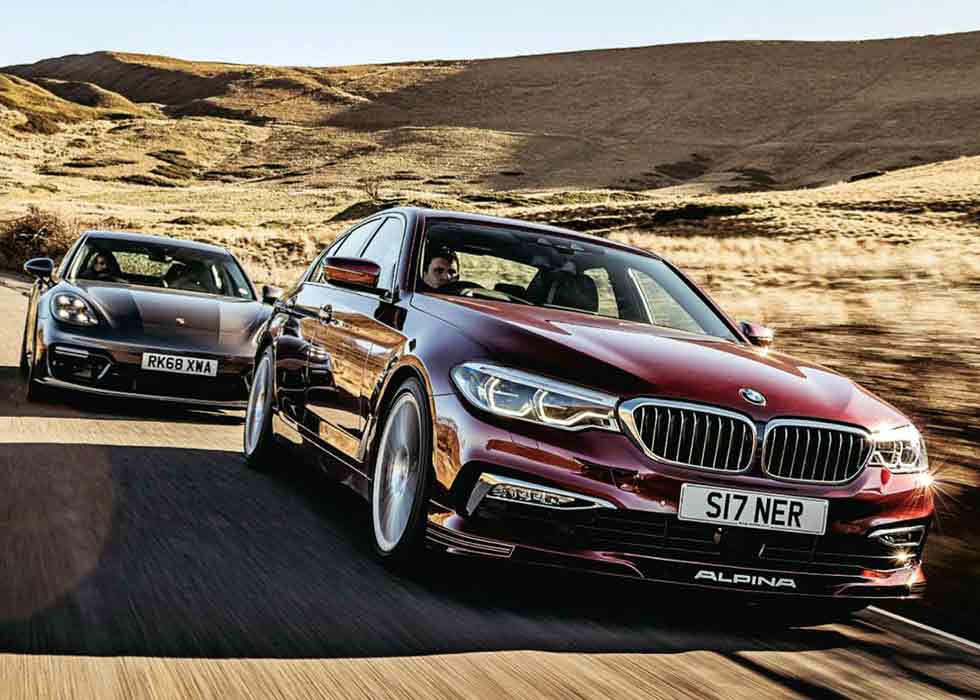
Subjectively, the Alpina feels even faster than the other two cars here, perhaps because of the complete contrast in the before and the after. Just a moment ago we were loping along in serene, refined comfort; now it feels like we’re midway through a land-speed-record attempt. Back off and you’ve returned to a relaxed cruise. The contrast is extraordinary.
It’s hard to imagine a better autobahn car: enormously comfortable, dragster fast
But then, the B5 is an extraordinary car. The tiny Bavarian company’s reimagining of the BMW 5-series has performance comparable to BMW’s own M5 F90, but they’re very different cars in character. On these undulating roads it’s clear the B5 has been tuned for comfort over agility. Although it rides low on shorter, stiffer springs than the regular 5-series, ride quality is uncannily smooth. Lumps, divots and potholes disappear beneath the chassis without a ripple. Alpina has developed its own settings for the B5’s electronic adaptive dampers, and even in their firmest Sport+ setting they’re far from jarring. (It’s entirely in keeping with the spirit of the B5 that Alpina has developed an extra-squishy Comfort+ setting within the drive modes.) As a result, the B5 doesn’t have an M5’s instant responses and keenness to change direction, but it’s certainly not clumsy. It seems almost impossible to shake the B5’s composure. Even going light over the Peak District’s countless off-camber crests, it never loses its poise. Active anti-roll control helps keep its weighty body in check, and unlike the M5 the B5 also features rear-wheel steering to increase high-speed stability and low-speed nimbleness. So thorough is Alpina’s overhaul it has even changed the lower front wishbones for its own design, to allow a little extra negative camber. The reserves of grip are so enormous that you rarely trouble its limits in normal driving.

Alpina reckons on zero to 125mph in 11.4 seconds, and if you can find enough space it’ll keep going all the way to 206mph. Both of those statistics feel entirely believable, and somehow absurd in an executive saloon car with massage seats and a heated steering wheel.
All that grip comes from bespoke Pirelli P-Zeroes, complete with Alpina-specific ALP markings on their side walls (another indicator of the engineering substance at play here) and wrapped around a set of 20-inch wheels in Alpina’s classic multi-spoked design. Together with the deep air dam at the front, they lend the B5 something of an ’80s vibe, as do the pinstripe decals along its flanks. (They’re fitted as standard, but can be removed at no cost.)
Inside, it’s the least adventurous in style of the three cars, based as it is on a conventional saloon, but it’s also the most relaxing and, arguably, the classiest. Alpina’s own skin for the digital instrument cluster tints the dials in its trademark shade of blue – nice touch – and their design changes according to drive mode. The driving position is superior to the AMG’s, and the seats are quite epically comfortable, finished in a soft, expensive-feeling grade of leather, with headrests like king-sized pillows. Alpina swaps the steering wheel for a thinner-rimmed item than the obese wheel in the M5, although it’s still the chunkiest tiller in the test.
Power delivery from the B5’s 4.4-litre twin-turbo V8 is as smooth as the suspension. Among the many upgrades, Alpina’s fitted its own choice of twin-scroll turbos, lavished plenty of attention on the cooling system and uprated the pistons and plugs. The result is 600bhp and 590lb ft (the standard M5 is 591bhp and 553lb ft), and thus the B5 is all-wheel drive by necessity. It’s a variable torque split, however, and for the vast majority of the time it’s very much rear-biased. It’s reassuring to know the traction’s there when you need it but, like the M5, it doesn’t spoil the car’s character (although unlike the M5, you can’t switch it to rear-drive mode).
It’s hard to imagine a better autobahn car: enormously comfortable, top-fuel-dragster fast, and entirely unruffled at a cruise. Apart, in this car, from a curious whistling noise at certain revs, like there’s a gap in its front teeth. Reassuringly, however, since Alpina’s relationship with BMW is so established, it is eligible for the same three-year extendable warranty as any regular BMW model. Likewise, the B5 can be serviced at any authorised dealer, workshop quirks limited to items such as air and oil filters and Alpina-specific brake pads.
An M5 might be quicker on a circuit, and the AMG is a rawer, more thrilling driving experience, but the B5’s grown-up feel, long-distance comfort and rarity value lend it an esoteric appeal all of its own.
Porsche the most sporty, Alpina the most relaxed.
The more we try other systems, the more we like BMW’s iDrive.
PRE-FLIGHT BRIEFING ALPINA B5 G30
Why is it here?
One of the finest four-doors on the planet, the B5 is a yardstick for comfort and for pace. Why the B5, not the BMW M5 F90? The AMG E63 is a more natural rival to the M car than the GT 4 Door, and the Alpina’s different ethos feels more of a match on the road; it’s more grown-up, more of a gran turismo in character than the M5. And if any car can keep up with it, they’re going well.
Any clever stuff?
Trick chassis (above) boasts all-wheel steering, variable all-wheel drive, active anti-roll control, adaptive dampers with Alpina’s own Comfort+ mode, and bespoke lower wishbones.
Which version is this?
The saloon, but there’s also a Touring, a strong contender for World’s Best Estate Car; BMW doesn’t make an M5 Touring. Diesel-fuelled sibling is the D5 S, with a 3.0-litre straight-six. Almost all B5s built to order; Alpina sells around 70 cars in the UK each year (1700- 1800 worldwide), so rarity value is part of its appeal.
2019 Porsche Panamera Turbo S E-Hybrid 971 Stuttgart’s 192mph miracle hybrid
The AMG GT 4 Door might be aiming at a narrow niche in the market but this key rival has shown it’s possible to make a comfortable home there. From frumpy beginnings the Panamera has matured into a cornerstone of Porsche’s range, a car that convincingly straddles the divide between limousine and sports car – just as the AMG aims to.
Like the Merc, the Panamera blends coupe and saloon design with a hatchback tailgate. It’s grown into its looks since its awkward early days and wears its 911-esque cues more convincingly, even if it’s still no beauty. Acid-green calipers show this car’s a hybrid, in this case the flagship Turbo S E-Hybrid, combining the twin-turbo V8 engine from the Panamera Turbo with the electric drivetrain from the Panamera 4 E-Hybrid.
That equates to 542bhp and 568lb ft from the V8, plus a 134bhp/295lb ft e-boost for a combined 671bhp and 627lb ft. The hardware makes it a weighty beast – over 2.3 tonnes – but it goes like a car half the weight. We’re following a dawdling SUV through a particularly tangled knot of B-roads in the hills, enjoying the Panamera’s soothingly pliant low-speed ride and well-insulated refinement, letting the powertrain unobtrusively switch between electric and bent-eight power. Rounding a bend, the road opens into a well-sighted straight. Click the Sport Response button in the middle of the drive-mode selector – that’s the full Al Pacino ‘gimme all ya got’ function, which musters all of the car’s energy, electric and internal combustion, for 20 seconds. Dithering traffic might as well not exist. There’s a swooshing, whooshing rush with undertones of burbling V8 and suddenly you’re a mile up the road.
Rotating the drive-mode wheel to Sport and Sport Plus triggers extra regenerative-energy capture to help keep the battery topped, and it remains close to full a long way into this test. Selecting either of the sportier modes when stationary instantly brings the V8 to life in readiness, and there’s no doubting its potency. The Porsche’s 4.0-litre V8 isn’t as charismatic as the rumbling AMG, but has a deep burbly note nonetheless (albeit one that’s more audible outside the car than in). It’s hooked up to an eight-speed PDK dual-clutch gearbox, which feels the most responsive of the three cars in manual paddleshift mode.
The Panamera rides on adaptive air suspension, and it feels more tied-down than the Alpina; there’s less float over crests and it’s keener to change direction. Small bumps tremor through the car more readily, and in sudden compressions and over larger bumps the car can be jogged vertically in a bouncing motion, no doubt partly a result of its weight and partly its larger wheels (the Porsche is on 21-inch wheels to the other cars’ 20s). But overall it rides very well, and it’s as relaxing to waft around unhurriedly as it is composed to drive at pace.
Its interior possesses the biggest wow factor of the trio. Its low-set dash offers a great view ahead, yet the low hip point means you still feel cocooned, and the infotainment displays look the cleanest here, the glassy central widescreen flowing into the digital instrument cluster (although still with an analogue revcounter in the centre) more neatly than in the other two. It’s a quicker system to learn than that of the AMG, although not without its quirks; the main touchscreen feels like it’s not quite calibrated accurately, seemingly responding more easily to a finger prod just off-centre than to one that’s bang on.
The lack of physical buttons on the gloss-black console around the gear selector makes it look uncluttered in comparison with the AMG but it takes a while to memorise its layout so you can use it without taking your eyes off the road. Of our three cars, I’d argue the Alpina’s iDrive system is the safest, most user-friendly media set-up, if the least avant garde.
The Porsche cabin’s an event for rear passengers. This car is fitted with optional rear-seat entertainment, which connects two removable tablet screens to the main infotainment system via a WLAN link, allowing rear passengers to browse the internet, play with apps or check in on the car’s vital stats – tyre pressures, fuel range and its current speed – so no Panamera pilot is safe from back-seat drivers. The upshot is that the Porsche feels special whichever seat you’re in, the overall atmosphere akin to a particularly low-flying private jet. It’s worth mentioning that the Mercedes is also available with a rear-seat multimedia package. Boot space is broadly comparable to the AMG; neither Panamera nor GT 4 Door can match the Alpina’s boot for volume, although their hatch doors have it beaten for accessibility.
Of the three the Panamera feels most like a sports car; low-set driving position, measured and accurate feedback from the steering wheel. It’s more responsive than the Alpina, and less immediate than the Mercedes, but similarly precise. The Panamera can’t completely disguise its weight, of course, and brake feel is occasionally slightly inconsistent, as with many hybrids, but it’s a very convincing package overall.
Big and heavy next to a 911, pin-sharp next to other GTs.
Low-slung Porsche blends analogue and digital well.
The cabin’s a real event for passengers, so the Porsche feels special whichever seat you’re in
PRE-FLIGHT BRIEFING PORSCHE PANAMERA
Why is it here?
It’s sitting pretty (well, pretty-ish) at the top of the four-door coupe grand tourer pile (okay, five doors if you count the tailgate). Like the AMG it has a turbocharged V8, spellbinding handling and a swoopy roof; it’s the benchmark.
Any clever stuff?
Oh yes. Networked chassis control, adaptive air suspension, torque vectoring, anti-roll control. And adaptive aero courtesy of the magic rear spoiler, assembling itself from its hiding place like an aerofoil-shaped Transformer.
Which version is this?
This is the regular saloon-style Panamera; it’s also available in quasiestate Sport Turismo shooting brake form. The line-up is vast. Conventionally engined models start with the V6 Panamera 4, then the quicker 4S, driver-focused V8 GTS, and super-quick Turbo. Hybrids kick off with the V6 4 E-Hybrid; this is the V8 Turbo S E-Hybrid. There’s no diesel.
FINAL RECKONING You can have it all
Three enormously charismatic cars, and each with more strengths than weaknesses. Choosing between the AMG GT 4 Door and the Alpina B5 is agonising. In a world of blank cheques you’d have both, because they contrast and complement each other perfectly. The Alpina’s combination of complete civility with earth-shattering pace is compelling, and if its comfort-orientated suspension makes it less sharp to drive than the other two (on a twisty road, at least), it also makes it the easiest of the three to live with every day.
The Mercedes is brasher, less urbane but more thrilling to drive more of the time, thanks to its combination of savage, almost lag-free V8 turbo power and quite astonishing body control. But there are a few too many negatives to detract from its dynamic brilliance: its infotainment interface is complicated and its screen graphics cluttered; refinement doesn’t feel up to snuff for a six-figure luxury car; and while its styling has bags of head-turning presence, it might just be a little too ungainly for some.
After a final drive in the GT my grin’s so wide I can’t help placing it ahead of the Alpina by a whisker – but while the AMG’s novelty might fade over time, I can imagine how satisfying a B5 would be to own long-term. An M5 might have come closer to the AMG for thrills, but the Alpina’s more rounded approach and rare-groove appeal take it from sports saloon to grand tourer in ethos. It’s quite a machine.
The Panamera, meanwhile, offers the best aspects of both rivals. It can cosset and waft almost as calmingly as the Alpina, corner like a racing car in the same vein as the AMG, and feel as shockingly quick in a straight line as them both. While good enough to take the win here, the Turbo S E-Hybrid isn’t necessarily the pick of the Panamera range, either – the lighter, purer regular Turbo S is a superb car. But still the S E-Hybrid is a dynamic match for the two lighter, less complex cars in this test.
The Panamera also makes the most interesting design statements of the three, outside and particularly within. It’s the most absorbing car to sit in, to drive and to spend time with. In a trio of star cars, it’s the Panamera that radiates the most star quality.
1st PORSCHE PANAMERA 971
Innovative, adventurous in style and glorious to drive. Practical enough, too. ★★★★★
2nd AMG GT 63S 4 DOOR
Full of charisma; amazing engine, physics-defying handling, but a few niggles. ★★★★★
3rd ALPINA B5 BITURBO
A mix of genius engineering, ease of use, thumping pace and want-one desirability. ★★★★★
GT 4 DOOR & RIVALS THE DETAIL
MERCEDES-AMG GT 63S 4 DOOR X290
AFFORDABILITY
£135,550 (£146,625 as tested with options)
Representative PCP £1499pm (36 payments): £32,469 deposit, 10k miles per year, 6.3% APR
Typical approved used value n/a (too soon)
POWERTRAIN
Engine 3982cc 32v twin-turbo V8
Transmission 9-speed auto, all-wheel drive
PERFORMANCE
Max Power 630bhp @ 5500rpm
Max Torque 663lb ft @ 2500rpm
Top speed 196mph
0-62mph 3.2sec
BODY/CHASSIS
Structure Aluminium and steel
Weight 2045kg
Suspension Multi-link front and rear, air springs, adaptive dampers
Length/width/height 5054/1887/1442mm
Boot capacity 461 litres
EFFICIENCY
Fuel capacity 92 litres
Official economy 21.4-22.1mpg
During test 16.2mpg
Range 433-447 miles (328 miles on test)
CO2 257g/km
ALPINA B5 BITURBO G30
AFFORDABILITY
£89,000 (£103,300 as tested with options)
Representative PCP £1564pm (36 payments): £20,660 deposit, 10k miles per year, 4.9% APR
Typical approved used value n/a (too rare)
POWERTRAIN
Engine 4395cc 32v twin-turbo V8
Transmission 8-speed auto, all-wheel drive
PERFORMANCE
Max Power 600bhp @ 5750rpm
Max Torque 590lb ft @ 3000rpm
Top speed 206mph
0-62mph 3.5sec
BODY/CHASSIS
Structure Aluminium and steel
Weight 1940kg
Suspension Double-wishbone front, multi-link rear, adaptive dampers
Length/width/height 4956/1868/1466mm
Boot capacity 530 litres
EFFICIENCY
Fuel capacity 68 litres
Official economy 26.9mpg
During test 17mpg
Range 402 miles (254 miles on test)
CO2 240g/km
PORSCHE PANAMERA TURBO S E-HYBRID 971
AFFORDABILITY
£137,140 (£159,537 as tested with options)
Representative PCP £1898pm (36 payments): £13,721 deposit, 10k miles per year, 6.7% APR
Typical approved used value £119,555
POWERTRAIN
Engine 3996cc 32v twin-turbo V8 + e-motor
Transmission 8-speed twin-clutch, all-wheel drive
PERFORMANCE
Max Power 671bhp @ 5750rpm
Max Torque 627lb ft @ 1960rpm
Top speed 192mph
0-62mph 3.4sec
BODY/CHASSIS
Structure Aluminium and steel
Weight 2310kg
Suspension Double-wishbone front, multi-link rear, air springs, adaptive dampers
Length/width/height 5049/1937/1427mm
Boot capacity 405 litres
EFFICIENCY
Fuel capacity 80 litres
Official economy 74.3-80.7mpg
Tested 14.2mpg
Range 1308-1420 miles (250 miles on test)
CO2 74g/km





